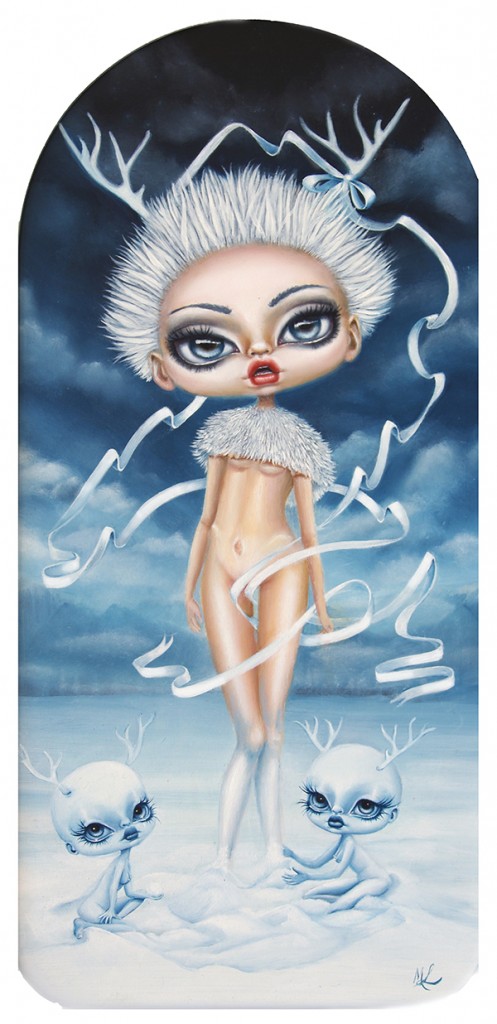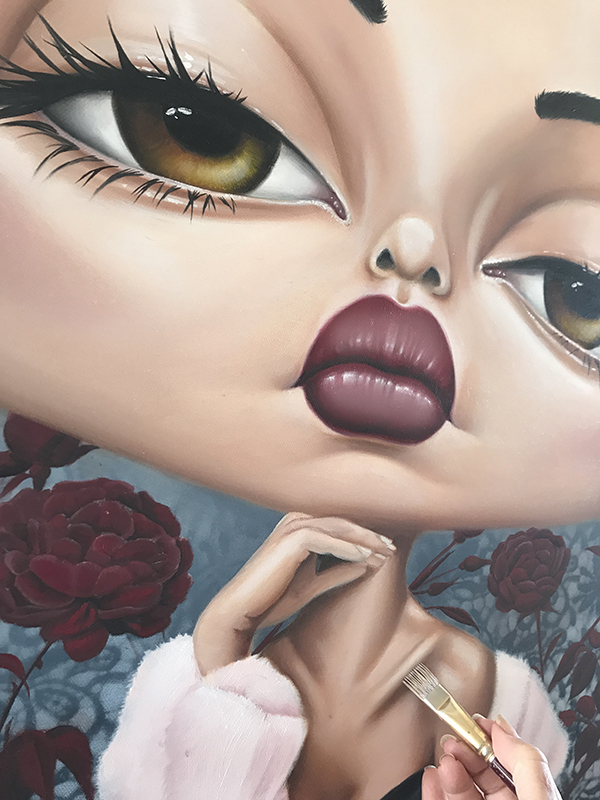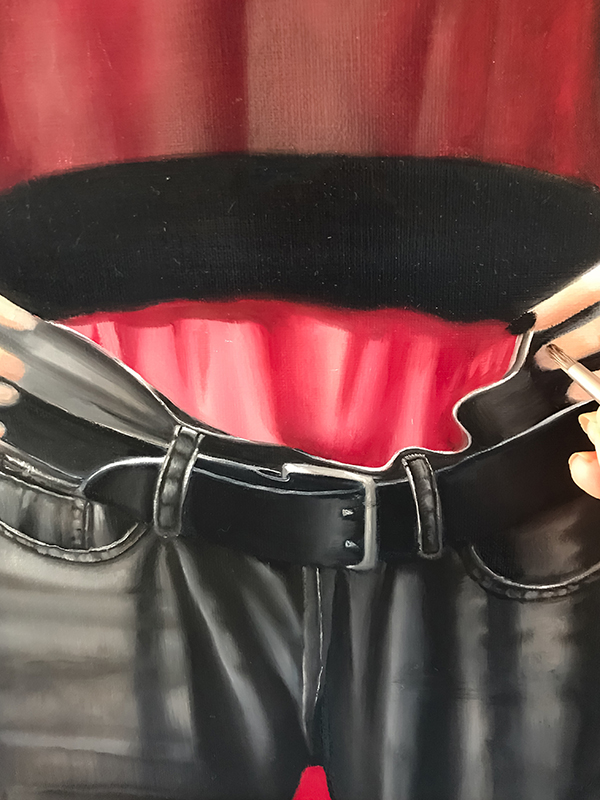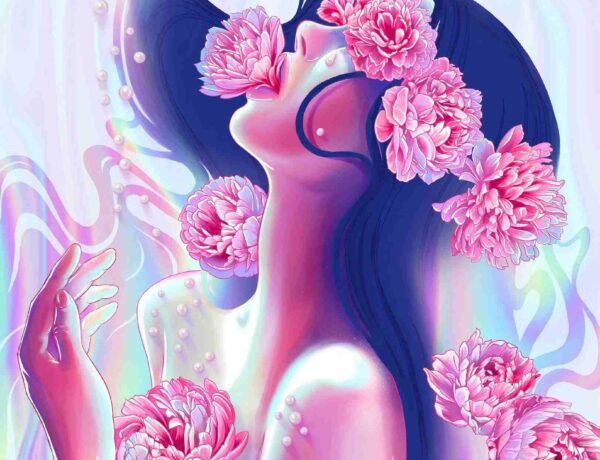Little parts of Marie Larkin’s world, that of green and wild landscapes replete with wildlife, and elements of both romance and spirituality, are reflected in her works of art. Sometimes blunted by the scholarly urge towards obviation, Marie’s latest works are all about letting go of the explicit and embracing open interpretation.
It’s an exciting time for Marie Larkin fans, and a good point at which to assess her recent artwork! Marie has made no secret of her artistic goals – it’s all there on the canvas – but decoding her paintings takes knowing some of the keen interests and core values at work in her busy brain.
Balance is one element Marie can make obvious in her works. For many of the lady-dynamos she paints, there is both a life giving, and a destructive side. Think of this impulse as comparable to the ancient Egyptians weighing a human heart against a feather, which, ideally, would balance out. In her paintings, Marie puts her finger on one, or the other, side of the scale, and gives a little push. In fact, she can embed dark and light features in the same painting. Therefore, the viewer’s interpretation says as much about them, as it does about Marie’s intentions. Let’s start with two pairs of paintings that really demonstrate this leitmotif.
Marie’s ‘Here, my Guarded Heart’ and ‘My Open Heart’s Soft Caress’, done for the 2017 Bitter Sweet group show (curated by Beautiful Bizarre Magazine), are two sides of one coin, and interesting in their own light.
‘Sweet’ merges with the cherry blossoms around her, a plucky redhead against a soft blue damask-like backdrop. Her energy is soothing and self-contained, and – as you can note from those telltale Larkin eyelashes – gentle. A soft caress on canvas. Her heart is a gift that only she can give. Beside her, ‘Bitter’ is armored; her heart is impaled and chained. Her eyes are keen and (literally) sharp under raptor-wing eyebrows. Only her long, dagger-like eyelashes show the disarray hidden behind the barriers she’s thrown up. This lady is no victim. She’s a steely survivor of brutal situations, who, Marie Larkin told me, she can consider ‘an alter ego’. And yet Marie balances that ironclad force with ‘Sweet’, nonetheless, whose heart is so much a gift that Marie bound her up in a bow (note the scarf) before the painting was finished.
You can see other symbols of balance in her paintings where powerful central figures are flanked by their handmaiden cohorts so that their composition creates a stable triangular shape. This imagery shows up, particularly, when Marie delves into what she told me were “Symbols of womanhood. Larger than life in a metaphorical sense.” Her goddesses.
Goddesses are central images in Marie’s work. They’re powerful (even super-powerful) expressions of Marie’s take on what is divine about womanhood. And, as you might expect, she does a wonderful job of introducing what is both great and terrible in these larger-than-life Muses.
‘Blackheart’ and ‘Heart of gold’ may not feature the junior-goddess handmaidens (you’ll meet these ladies later), but they speak to two archetypes of women that are prevalent in modern Western culture. The terrible goddess, ‘Blackheart’, walks toward us across a sea of malice, wearing her heart as little more than decoration, she’s replaced even the injury of losing it with a fanged and bestial mouth. This is despair. In fact, when Marie told me about these two paintings, she quoted Samuel Richardson re. Blackheart: ‘Oh, how can wicked men seem so steady and untouched with such black hearts, while poor innocents stand like malefactors before them!’ Blackheart is betrayal given a woman’s form; Marie’s effective stab at a Greek Fury.
On the shore it’s sunset, and you arrive at a spring-like figure right at the edge of a cliff. It would be easy to see this as the young-goddess counterpart to threatening ‘Blackheart’, now staring out at a darkening ocean. Marie said of ‘Heart of gold’, “I don’t think I could bear it if I thought the world was completely dominated by anger”, and whenever I see this wounded girl sending her heart out into the world, part of me likes to think she’s very much trying to rescue fellow-goddess, ‘Blackheart’. Marie’s take – “she sacrifices herself and offers the one thing that can save this world from itself, a kind heart, and with it, hope” – doesn’t preclude the idea.
But Marie’s take on the divinity of the feminine goes beyond forces of Darkness and Light. It’s more complex than the duality can contain, and so the concept fills up and gushes over its bounds.
Ecstasy is one of the essentials of Marie’s work, and you’ll see it highlighted alongside notions of fullness, emptiness, power and surrender. Its form changes, but she’s clearly interested in exploring the notion of feminine fulfillment, for better (hopeful ‘Heart of gold’) and worse (malevolent ‘Blackheart’).
Collage by Tracy Eire
‘Our Lady of the Suckling Tree’ is one of the most absorbing of her implementations! Shown here at the center of ‘Pietà’ by Gregorio Fernández, and Bernini’s ‘The Ecstasy of Saint Teresa’, this painting says great volumes about the suffering of our ultimate Mother – Nature. In Marie’s words, “the ultimate mother nature goddess offers herself, almost martyr-like in her sacrifice, eyes fixed on the heavens as she provides succor”.
This is a complicated image. There are elements of a three-fold goddess in this painting, but also iconography of crucifixion. Such an extreme sacrifice is a strange thing to tie ecstasy to, but Saint Teresa described her religious ecstasy in terms you might equate with Game of Thrones. To set the stage: an angel showed up one night – unfortunately, he was carrying a burning spear:
“He appeared to me to be thrusting it at times into my heart, and to pierce my very entrails; when he drew it out, he seemed to draw them out also, and to leave me all on fire with a great love of God. The pain was so great that it made me moan, and yet so surpassing was the sweetness of this excessive pain, that I could not wish to be rid of it.”
Yes, this quote is very much about the sexual repression and sublimation of women that is rampant in so many cultures, but, in a sense, you do this sort of thing for your children. And, in Mother Nature’s case, that’s the entire natural world. So, while her little cherubs may be sucking her dry, she is martyred by her love for them. That’s why I can also compare this piece to the Pietà. Literally, she must be shown mercy.
Marie knows that being a mother isn’t as cut and dried as on television.
Motherhood is a recurring theme, and, like the waterfall below, it flows from painting to painting.
“The paintings all allude to images of the Madonna but are not sacred in a directly religious sense. Essentially these works explore the notion of woman as creator, nurturer and life-giver.” Says Marie. ‘The Source’ is a Mother goddess figure and fountainhead, and her handmaidens seem more supplicant than servant. Perhaps their end goal is the kind of intimate relationship you see in both ‘Silent Communication’ and ‘The Closed Circle’ – another kind of ecstasy. Marie uses a part of aviator Anne Morrow Lindburgh’s quote, “In the sheltered simplicity of the first days after a baby is born, one sees again the magical closed circle, the miraculous sense of two people existing only for each other” to describe this theme.
Is there power in motherhood? Infinite power, Marie suggests. It’s woman as ‘Force of Nature’, the title of the painting below, into which Marie tucked a formidable Mother goddess, awe-stricken handmaidens, a womb, ovaries, Fallopian tubes, and life-giving water. All of it, to Marie’s way of thinking, divine.
A better awareness of core elements in Marie Larkin’s work makes viewing her finished products quite a treat! Take the painting below as an example. The horned-woman is almost certainly a goddess. Her handmaidens attend her by packing the snow from which she emerges. Her soft-lashed eyes are friendly, and she’s dressed in a long, pale bow. In ‘Winter Venus’, Marie points out that though winter strips the world of life, it is a natural wonder, rather than a truly destructive force.
And what do you make of this balancing act? The painting, ‘Love Potion’.
Are cherubs drugging a woman into submission? Or, since the water they’re feeding her is a symbol of life and fertility, is she going willingly into ecstatic swoon? Marie would say the latter, but, going forward, final interpretation will be in the eye of the beholder.
What’s next for Marie? Enjoy this sneak-peek of upcoming works!
For more of Marie’s artwork (and more news of the upcoming tattoo!), please visit her website or join her on her Instagram!
















